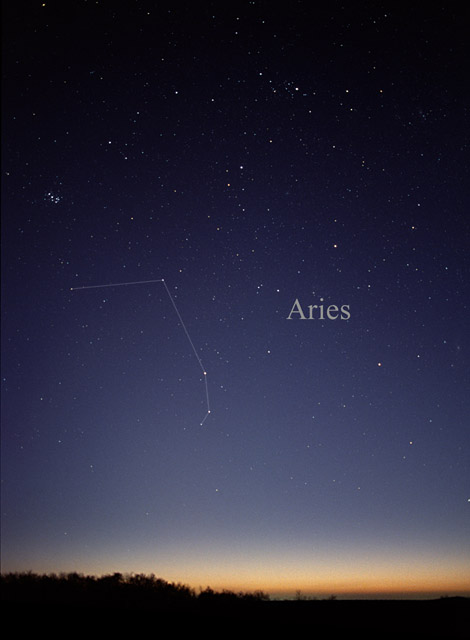|
╬▓ Arietis
Beta Arietis is a binary star system in the constellation of Aries, marking the ram's second horn. Its identifier is a Bayer designation that is Latinized from ╬▓ Arietis, and abbreviated Beta Ari or ╬▓ Ari. It has the official name Sheratan, pronounced . This system is visible to the naked eye as a point of light with a combined apparent visual magnitude of 2.65, making this the second-brightest star in the constellation. Located at a distance of , the pair orbit each other with a period of 107 days. Nomenclature ''Beta Arietis'' is the star's Bayer designation. It also bears the Flamsteed designation ''6 Arietis''. The traditional name, ''Sheratan'' (or ''Sharatan, Sheratim),'' in full ''Al Sharatan,'' is from the Arabic ž¦┘äž┤ž▒žĘž¦┘å ''a┼Ī-┼Īara┼Ż─ün'' "the two signs", a reference to the star having marked the northern vernal equinox together with Gamma Arietis several thousand years ago. In 2016, the International Astronomical Union organized a Working Group o ... [...More Info...] [...Related Items...] OR: [Wikipedia] [Google] [Baidu] |
Aries (constellation)
Aries is one of the constellations of the zodiac. It is located in the Northern celestial hemisphere between Pisces (constellation), Pisces to the west and Taurus (constellation), Taurus to the east. The name Aries is Latin for sheep, ram. Its traditional astrological symbol is (ŌÖł’ĖÄ). It is one of the 48 constellations described by the 2nd century astronomer Ptolemy, and remains one of the 88 modern constellations. It is a mid-sized constellation ranking 39th in overall size, with an area of 441 square degrees (1.1% of the celestial sphere). Aries has represented a ram since late Babylonian times. Before that, the stars of Aries formed a farmhand. Different cultures have incorporated the stars of Aries into different constellations including twin inspectors in China and a porpoise in the Marshall Islands. Aries is a relatively dim constellation, possessing only four bright stars: Hamal (Alpha Arietis, second magnitude), Sheratan (Beta Arietis, third magnitude), Mesarthim ( ... [...More Info...] [...Related Items...] OR: [Wikipedia] [Google] [Baidu] |
Parallax
Parallax is a displacement or difference in the apparent position of an object viewed along two different sightline, lines of sight and is measured by the angle or half-angle of inclination between those two lines. Due to perspective (graphical), foreshortening, nearby objects show a larger parallax than farther objects, so parallax can be used to determine distances. To measure large distances, such as the distance of a planet or a star from Earth, astronomers use the principle of parallax. Here, the term ''Stellar parallax, parallax'' is the semi-angle of inclination between two sight-lines to the star, as observed when Earth is on opposite sides of the Sun in its orbit. These distances form the lowest rung of what is called "the cosmic distance ladder", the first in a succession of methods by which astronomers determine the distances to celestial objects, serving as a basis for other distance measurements in astronomy forming the higher rungs of the ladder. Because parallax ... [...More Info...] [...Related Items...] OR: [Wikipedia] [Google] [Baidu] |
Stellar Rotation
Stellar rotation is the angular motion of a star about its axis. The rate of rotation can be measured from the spectrum of the star, or by timing the movements of active features on the surface. The rotation of a star produces an equatorial bulge due to centrifugal force. As stars are not solid bodies, they can also undergo differential rotation. Thus the equator of the star can rotate at a different angular velocity than the higher latitudes. These differences in the rate of rotation within a star may have a significant role in the generation of a stellar magnetic field. In its turn, the magnetic field of a star interacts with the stellar wind. As the wind moves away from the star its angular speed decreases. The magnetic field of the star interacts with the wind, which applies a drag to the stellar rotation. As a result, angular momentum is transferred from the star to the wind, and over time this gradually slows the star's rate of rotation. Measurement Unless a star ... [...More Info...] [...Related Items...] OR: [Wikipedia] [Google] [Baidu] |
Red Giant
A red giant is a luminous giant star of low or intermediate mass (roughly 0.3ŌĆō8 solar masses ()) in a late phase of stellar evolution. The stellar atmosphere, outer atmosphere is inflated and tenuous, making the radius large and the surface temperature around or lower. The appearance of the red giant is from yellow-white to reddish-orange, including the stellar classification, spectral types K and M, sometimes G, but also S-type star, class S stars and most carbon stars. Red giants vary in the way by which they generate energy: * most common red giants are stars on the red-giant branch (RGB) that are still stellar nucleosynthesis, fusing hydrogen into helium in a shell surrounding an inert helium core * red-clump stars in the cool half of the horizontal branch, fusing helium into carbon in their cores via the triple-alpha process * asymptotic-giant-branch (AGB) stars with a helium burning shell outside a degenerate carbonŌĆōoxygen core, and a hydrogen-burning shell just beyo ... [...More Info...] [...Related Items...] OR: [Wikipedia] [Google] [Baidu] |
G-type Main-sequence Star
A G-type main-sequence star (spectral type: G-V), also often, and imprecisely, called a yellow dwarf, or G star, is a main sequence, main-sequence star (luminosity class V) of stellar classification, spectral type G. Such a star has about 0.9 to 1.1 solar masses and an effective temperature between about . Like other main-sequence stars, a G-type main-sequence star converts the Chemical element, element hydrogen to helium in its core by means of nuclear fusion. The Sun, the star in the center of the Solar System to which the Earth is gravitationally bound, is an example of a G-type main-sequence star (G2V type). Each second, the Sun fuses approximately 600 million tons of hydrogen into helium in a process known as the protonŌĆōproton chain (4 hydrogens form 1 helium), MassŌĆōenergy equivalence, converting about 4 million tons of matter to energy. Besides the Sun, other well-known examples of G-type main-sequence stars include Alpha Centauri, Tau Ceti, and 51 Pegasi. Description Th ... [...More Info...] [...Related Items...] OR: [Wikipedia] [Google] [Baidu] |
MK Spectral Classification
In astronomy, stellar classification is the classification of stars based on their spectral characteristics. Electromagnetic radiation from the star is analyzed by splitting it with a prism or diffraction grating into a spectrum exhibiting the rainbow of colors interspersed with spectral lines. Each line indicates a particular chemical element or molecule, with the line strength indicating the abundance of that element. The strengths of the different spectral lines vary mainly due to the temperature of the photosphere, although in some cases there are true abundance differences. The ''spectral class'' of a star is a short code primarily summarizing the ionization state, giving an objective measure of the photosphere's temperature. Most stars are currently classified under the MorganŌĆōKeenan (MK) system using the letters ''O'', ''B'', ''A'', ''F'', ''G'', ''K'', and ''M'', a sequence from the hottest (''O'' type) to the coolest (''M'' type). Each letter class is then subdivided ... [...More Info...] [...Related Items...] OR: [Wikipedia] [Google] [Baidu] |
NStars
The ''Nearby Stars Database'' (NStars) began as a NASA project in 1998, then was based at Northern Arizona University. It is now defunct. The stated mission of NStars was "to be a complete and accurate source of scientific data about all stellar systems within 25 parsecs The parsec (symbol: pc) is a unit of length used to measure the large distances to astronomical objects outside the Solar System, approximately equal to or (AU), i.e. . The parsec unit is obtained by the use of parallax and trigonometry, and ...." The website (see below) included search tools and links to an interactive forum. Status As of 1 January 2002, there were 2,633 stars in 2,029 systems in the database. As of 29 January 2008, the site is closed, displaying the message ''"This site is currently undergoing a major redesign and will be returned to service at a later date."'' References External links Nearby Stars Database on the Wayback MachineThe Extrasolar Planets Encyclopaedia* ttps://web. ... [...More Info...] [...Related Items...] OR: [Wikipedia] [Google] [Baidu] |
Thermonuclear Fusion
Nuclear fusion is a reaction in which two or more atomic nuclei combine to form a larger nuclei, nuclei/neutron by-products. The difference in mass between the reactants and products is manifested as either the release or absorption of energy. This difference in mass arises as a result of the difference in nuclear binding energy between the atomic nuclei before and after the fusion reaction. Nuclear fusion is the process that powers all active stars, via many reaction pathways. Fusion processes require an extremely large triple product of temperature, density, and confinement time. These conditions occur only in stellar cores, advanced nuclear weapons, and are approached in fusion power experiments. A nuclear fusion process that produces atomic nuclei lighter than nickel-62 is generally exothermic, due to the positive gradient of the nuclear binding energy curve. The most fusible nuclei are among the lightest, especially deuterium, tritium, and helium-3. The oppo ... [...More Info...] [...Related Items...] OR: [Wikipedia] [Google] [Baidu] |





